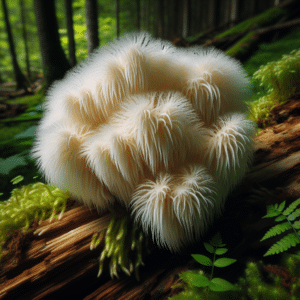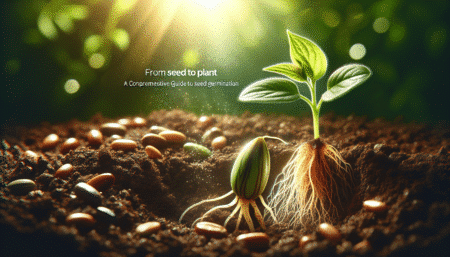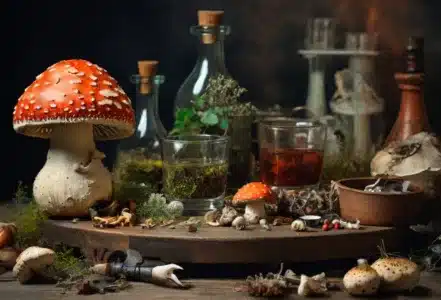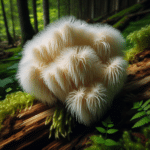- Welcome to the Wood Wide Web
- The Wood Wide Web: The underground network of trees
- Chemical signals: the language of plants
- Root communication: More than just food intake
- Reaction to threats: Defense mechanisms of the plant world
- Conclusion and outlook
1. welcome to the Wood Wide Web
The Wood Wide Web is a fascinating hidden world where trees and plants are connected by a network of fungi, similar to the internet we use every day. This unique connection benefits both the trees, which provide the fungi with sugar from photosynthesis, and the fungi, which in turn provide the trees with water and nutrients [1]. This symbiotic relationship not only contributes to the exchange of nutrients and water, but also enables communication between the trees and protects them from diseases and toxins [1][2]. Despite the essential role that the Wood Wide Web plays in our ecosystem, there is still debate in the scientific community about the extent of this communication and resource sharing between trees [3][4].
This series of articles dives deep into the Wood Wide Web, exploring the complex network of mycorrhiza that enables the exchange of water, nutrients and information between trees, and examines how it helps trees communicate with each other, support each other during periods of stress and increase their resistance to disease and pests [2]. We will also explore the challenges and criticisms associated with the concept of the Wood Wide Web and emphasize the need for further research to understand the true scope of tree communication and resource sharing [3][4].
2 The Wood Wide Web: The underground network of trees
- Underground communication through fungi and rootsThe so-called "Wood Wide Web" is a network of fungi and roots that enables plants to share nutrients and send signals to each other [6]. This extensive underground network allows trees to communicate with each other and exchange information [7].
- Mycelium and mycorrhizaAt the center of this network is the mycelium, a type of fungus that forms a symbiotic relationship with tree roots to form a mycorrhiza [7]. This relationship supports the exchange of nutrients and water between the trees [7]. In addition to the underground signals sent by the mycorrhizal network, trees can also send signals above ground through volatile organic compounds (VOCs) such as terpenes [7].
- Perception and communication skills of the trees:
- The root tips of trees have a brain-like organ that helps them to perceive and process signals from the environment. This organ can recognize physical factors such as gravity, light, moisture, oxygen and nutrients and transmit this information to the rest of the tree [7].
- The mycorrhizal networks also enable the transmission of chemical and electrical signals. This communication is facilitated by the fact that the root tips of the trees can recognize and communicate with each other, demonstrating a form of self-awareness [7].
- Plants also communicate through their root systems, using hormones and other chemicals to interact with neighboring plants. This network of communication helps plants to coordinate their growth and defend themselves against threats [10].
3. chemical signals: the language of plants
Plants use a variety of chemical signals to communicate with their environment and other plants. These signals serve a variety of purposes, from warning of danger to attracting pollinators. Here's a detailed look at this chemical language:
- Communication underground:
- Root exudatesRoots send out chemical signals, known as root exudates, to inform neighboring plants of threats or to facilitate the exchange of nutrients and water [11].
- Systemic responseSalicylic acid and jasmonic acid (jasmonates) serve as signals for the systemic response. These signals can also be transmitted to neighboring plants, triggering a systemic response in these plants as well [16].
- Communication above the earth:
- Volatile organic compounds (VOCs)Plants communicate by releasing VOCs to signal their state to the environment. The type of VOCs emitted can vary depending on the plant's history with herbivores. Plants that have had frequent contact with herbivores emit a general pattern of VOCs that can be understood by a wider range of plants. Plants that have had little contact with herbivores emit a more specific VOC pattern that is only understood by closely related plants [13].
- Optical and chemical signalsPlants can also communicate through visual and chemical signals. Visual signals include physical characteristics such as hairs on stems or color patterns on leaves that repel or attract certain animals. Chemical signals are usually in the form of scents or gases released by the plant to communicate with its environment. These signals serve two main purposes: reproduction and protection [14].
- Specific receptors and genetic modifications:
- Receptors for gas hormonesPlants communicate with each other through chemical signals and use a specific receptor to sense gas hormones such as ethylene. Genetically modified plants have been developed that have a blocked ethylene receptor, which means they do not respond to the ethylene signal and therefore have a longer shelf life for fruits such as bananas and tomatoes [15].
These complex communication systems emphasize the ability of plants to respond and adapt to their environment, making them important players in their ecosystems.
- Receptors for gas hormonesPlants communicate with each other through chemical signals and use a specific receptor to sense gas hormones such as ethylene. Genetically modified plants have been developed that have a blocked ethylene receptor, which means they do not respond to the ethylene signal and therefore have a longer shelf life for fruits such as bananas and tomatoes [15].
4. root communication: more than just food intake
Plant roots play a crucial role in communication by identifying and communicating with other plant roots. This ability enables plants to exchange information about their immediate environment and respond to changes [12].
- Acoustic communication:
- Plants can communicate acoustically through ultrasonic sounds (20-100 KHz). The frequency and intensity of these sounds increase under stress conditions [12].
- A study from 2023 has shown that plants can communicate acoustically by producing one sound per hour under normal conditions and significantly more under stress [12].
- Researchers have discovered that plants can communicate with cracking sounds that lie in the frequency range of around 220 Hertz. Plants direct their growth towards the acoustic source if the sound waves are in the frequency range of 220 Hz [17].
- Communication between leaves and roots:
- The Center for Plant Molecular Biology (ZMBP) at the University of Tübingen focuses on research into how leaves communicate with roots during the symbiosis of plants with nitrogen-fixing bacteria [18].
- The study discovered that leaves send a short RNA sequence, miR2111, to the roots to keep the plant susceptible to infection by symbiotic bacteria until a favorable balance is established [18].
These findings underline the complexity of plant communication, which goes far beyond simple food intake. The ability of plants to communicate acoustically and send specific signals between different parts of the plant opens up new perspectives for understanding interactions within the ecosystem and developing innovative approaches in plant management and forestry.
5. reaction to threats: Defense mechanisms of the plant world
Plants have developed unique mechanisms to respond to threats from their environment. These defense strategies can be divided into chemical, mechanical and structural defense mechanisms:
- Chemical defense:
- Plants produce secondary plant substances such as ethylene, which regulates the ripening process of fruits and can influence neighboring fruits [10].
- Methyl salicylate is produced when plants are infected with harmful viruses or bacteria. It acts as a natural pest control agent and warns neighboring plants of the danger [10].
- Systemin, a peptide in the nightshade family, plays a crucial role in plant defense against herbivorous insects. It triggers the production of jasmonic acid, which in turn leads to the synthesis of protease inhibitors and quinolines, which disrupt the metabolism of attacking insects [19].
- Mechanical and structural defense:
- Thorns and spikesServe as physical barriers to ward off herbivorous animals [16].
- Structure of the finishing fabricThe rhizodermis, epidermis with cuticle and wax layer act as barriers against intruders. Wounds and stomata are preferred entry points for pathogens. Some wheat varieties open their stomata later in the day so that the fungal spores germinated in the humidity of the night have already dried out before they can penetrate [16].
- Biochemical reactions:
- When an attacker is recognized, biochemical reactions are triggered in cells and tissues that produce and translocate substances that are toxic or growth-inhibiting for the pathogen. These include the formation of callose, programmed cell death (apoptosis) of infected cells, the formation of activated oxygen molecules, the formation of toxic molecules of secondary metabolism (phytoalexins) and the induction of PR proteins or pathogen-related proteins such as chitinase and glucanase [16].
These defense mechanisms show how plants respond to threats in a variety of ways, from producing specific chemicals to developing physical barriers and activating their immune systems.
6 Conclusion and outlook
The fascinating world of plant communication that we have explored in this article shows just how complex and sophisticated interactions are in the plant kingdom. From the exchange of chemical signals underground to acoustic communication and response to threats, the Wood Wide Web reveals a vast system of cooperation and survival that is essential for plant health and growth, as well as for the ecosystem as a whole. The symbiosis made possible by fungi and roots not only contributes to the exchange of nutrients and information, but also strengthens the common defense system against diseases and pests.
Much remains to be explored about the exact mechanisms and the full scope of plant communication. The findings presented and the unanswered questions point to the need for further research to deepen our understanding of these remarkable natural phenomena. The implications for forestry, environmental protection and agricultural practice are enormous, emphasizing the importance of biodiversity conservation and challenging us to find innovative ways to manage our natural resources sustainably.
Further questions and answers on plant communication
How does the so-called Wood Wide Web work?
The Wood Wide Web, often referred to as the Internet of the forest, is based on a network of fine fungal threads that run through the forest floor. These threads establish a connection between trees, shrubs and most higher plants.
How do trees exchange information with each other?
Trees are able to absorb and process information via their leaves and root tips and react accordingly. They communicate both internally and with each other. Research shows that plants have far more abilities than previously assumed.
Why is the mycorrhizal network referred to as the "Wood Wide Web"?
Researcher Suzanne Simard discovered the network of mycorrhizal fungi and plant roots and named it the Wood Wide Web. The mycelia of mycorrhizal fungi connect the root tips of different trees with each other, creating an extensive communication network.
Who is the discoverer of the Wood Wide Web?
Dr. Suzanne Simard coined the term Wood Wide Web in 1990 and discovered the phenomenon behind it. It is a complex network of roots and mycorrhizal fungi that enables communication and mutual support between trees and other plants.
Further links
- https://www.mein-schoener-garten.de/lifestyle/natur-tiere/die-kommunikation-der-pflanzen-33036
- https://www.textatelier.com/index.php?id=996&blognr=2350
- https://animaltalk.com.au/can-plants-really-communicate-with-us/
- Wolf-Dieter Storl - Plant devas (book)
- Peter Wohlleben - The Secret Life of Trees: The Discovery of a Hidden World (book)
Youtube
References
Read more: Wood Wide Web: Die verborgene Welt der Pflanzenkommunikation[1] – https://www.baumpflegeportal.de/sonstiges/wood-wide-web-wahrheit-mythos/
[2] – https://utopia.de/ratgeber/wood-wide-web-was-ist-das-und-wie-funktioniert-es_294435/
[3] – https://www.scinexx.de/news/biowissen/was-ist-dran-am-wood-wide-web/
[4] – https://www.geo.de/natur/oekologie/wood-wide-web–wie-vernetzt-sind-baeume-wirklich–33194662.html
[5] – https://science.orf.at/stories/3217759/
[6] – https://www.deutschlandfunkkultur.de/die-intelligenz-der-pflanzen-104.html
[7] – https://www.nationalgeographic.de/umwelt/2022/05/wood-wide-web-koennen-baeume-miteinander-sprechen
[8] – https://www.pflanzenforschung.de/de/pflanzenwissen/journal/unterirdischer-naehrstoffhandel-baeume-sind-gute-netzwe-10619
[9] – https://www.derstandard.at/story/2000144500892/existiert-das-mysterioese-internet-der-baeume-wirklich
[10] – https://www.mein-schoener-garten.de/lifestyle/natur-tiere/die-kommunikation-der-pflanzen-33036
[11] – https://growshit.de/blogs/news/die-funktion-der-wurzel
[12] – https://www.tierwelt.ch/artikel/natur-umwelt/wie-kommunizieren-pflanzen-501578
[13] – https://www.pflanzenforschung.de/de/pflanzenwissen/journal/lauschangriff-erwuenscht-schadinsekten-foerdern-eine-oe-11105
[14] – https://www.geo.de/geolino/natur-und-umwelt/9223-rtkl-botanik-die-sprache-der-pflanzen
[15] – https://www.fr.de/wissen/forscher-lernen-chemische-sprache-pflanzen-11400451.html
[16] – https://www.spektrum.de/lexikon/biologie/pflanzliche-abwehr/50728
[17] – https://www.geo.de/natur/oekologie/3447-rtkl-bioakustik-pflanzen-kommunikation-sags-durch-die-wurzel
[18] – https://uni-tuebingen.de/fakultaeten/mathematisch-naturwissenschaftliche-fakultaet/fachbereiche/zentren/zentrum-fuer-molekularbiologie-der-pflanzen/zmbp/news/press-activities-colloquia/newsfullview-zmbp/article/wie-blaetter-mit-den-wurzeln-sprechen/
[19] – https://www.pflanzenforschung.de/de/pflanzenwissen/journal/abwehr-mit-system-ein-hormon-hilft-nachtschattengewaech-10931
[20] – https://cordis.europa.eu/article/id/32170-scientists-shed-light-on-plant-defence-quagmire/de
[21] – https://www.pflanzenforschung.de/de/pflanzenwissen/journal/vielfalt-und-kompromisse-bei-der-pflanzenabwehr-1215
[22] – https://de.wikipedia.org/wiki/Abwehr_(Biologie)
[23] – https://www.mpg.de/18174133/chemische-abwehr-gegen-pflanzensaftsaugende-zikaden-entschluesselt
[24] – https://www.bmbf.de/bmbf/shareddocs/kurzmeldungen/de/forschung-fuer-nutzpflanzen-der-zukunft.html
[25] – https://www.forschung-und-lehre.de/zeitfragen/die-kartoffel-der-zukunft-3986
[26] – https://www.oekom.de/buch/zukunft-fuer-alle-9783962382575
















